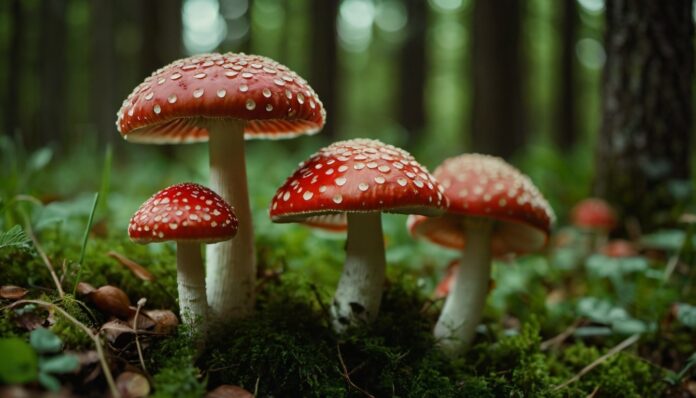Fly agarics, also known as Amanita muscaria, are easily recognizable mushrooms with their bright red caps dotted with white spots. Often depicted in fairy tales and folklore, these mushrooms are both fascinating and toxic.
While they have been used in traditional rituals and medicine, consuming them can cause hallucinations and other serious health issues. Found in forests across the Northern Hemisphere, fly agarics continue to intrigue both scientists and enthusiasts with their striking appearance and complex properties.
Interesting Facts About Fly Agarics
- Fly agarics are scientifically known as Amanita muscaria.
- They are commonly recognized by their bright red caps with white spots.
- These mushrooms grow primarily in the Northern Hemisphere, in both temperate and boreal forests.
- Fly agarics form symbiotic relationships with trees, particularly birch and pine.
- The name “fly agaric” comes from their traditional use to attract and kill flies.
- In folklore, fly agarics are often depicted as homes for gnomes and fairies.
- They are featured in many children’s books and video games, such as “Alice in Wonderland” and “Super Mario.”
- Fly agarics contain toxic compounds, including muscimol and ibotenic acid.
- Despite their toxicity, some cultures have used them for their psychoactive effects in shamanistic rituals.
- Symptoms of fly agaric poisoning can include nausea, hallucinations, and delirium.
- Cooking and drying the mushrooms can reduce their toxicity but does not eliminate it.
- Fly agarics have been used in traditional medicine for various purposes, such as treating pain and inflammation.
- The mushroom’s red and white color scheme is often associated with Christmas, speculated to have influenced the appearance of Santa Claus.
- Fly agarics can grow quite large, with caps reaching up to 12 inches in diameter.
- They are classified as basidiomycete fungi, within the genus Amanita.
- The white spots on the cap are remnants of the universal veil that covers immature mushrooms.
- Fly agarics are often found in fairy rings, circular arrangements of mushrooms.
- They have a symbiotic relationship with trees, helping them absorb water and nutrients.
- The psychoactive effects of fly agarics can vary widely, depending on the region and age of the mushroom.
- Reindeer in Siberia are known to eat fly agarics, and their behavior afterward may have inspired some Christmas traditions.
- Fly agarics are sometimes confused with other red-capped mushrooms, some of which are more toxic.
- The caps of fly agarics are often used as decorations or symbols in various cultures.
- In some parts of the world, fly agarics are used as insect repellents.
- The mushroom’s spores are released from gills underneath the cap.
- Fly agarics have a distinctive smell, often described as earthy or musky.
- The white stalk of the fly agaric is typically adorned with a skirt-like ring.
- Ingesting fly agarics can cause a condition known as mycetism, or mushroom poisoning.
- Fly agarics have been depicted in art and literature for centuries, symbolizing mystery and the supernatural.
- The mushrooms can survive in a wide range of soil types and climates.
- Scientists continue to study fly agarics for their unique chemical compounds and potential medicinal uses.
